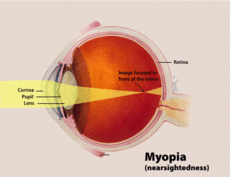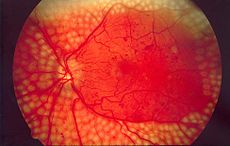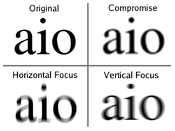Amblyopia
The visual system affected
The condition affects the optic nerve of the eye.
A comprehensive description of the condition
Amblyopia is an eye condition that is identified by impaired vision. The condition is caused by the failure of the optic nerves to transmit visual sensation to the brain (Cassin 619). The condition comes about when the brain fails to process the visual sensation of the affected eye resulting in double or blurred vision.
The effects of the condition on the visual system
The condition may result in the abnormality of the visual system particularly in children when not treated early.
The common treatments
The common treatments of the condition include surgery, use of spectacles that correct the optical deficit, patching the good eye to condition the amblyopic eye as well as the application of eye ointments such as topical atropine.

An example of where one eye is patched to condition the amblyopic eye
Whether the condition is congenital or adventitious progressive or stable
The condition is adventitious, progressive, or stable.
The anticipated functional implications
People affected will have poor or spatial visual acuity. In addition, those affected may have permanent functional blindness, particularly in the circumstances that the affected eye is not treated (Wood 366).
Myopia
The visual system affected
The condition affects the eye lenses that fail to focus the light rays from distant objects into the macula.
The comprehensive description of the condition
Sometimes referred to as nearsightedness, the condition occurs when the lenses fail to focus the light rays into the macula. In fact, the light-ray focal point is in front of the retina causing the image of distant objects to appear blurred.

The effects of the condition on the visual system
Myopia results in the axial length of the eye. The axial length is the increased distance between frontal and posterior poles of the eye, refractive actions of the cornea as well as in the disparities of the index refraction of the optical media (Kertes 399).
The common treatments
Myopia is often treated with refractive surgery as well as the use of corrective glasses.
Whether the condition is congenital or adventitious progressive or stable
The condition is both congenital, adventitious, progressive, and stable.
The anticipated functional implications
The people affected will have problems with far-away visualization in the classroom.
Glaucoma
The visual system affected
The condition results from the loss of the retinal ganglion cells occasioned by the reparation of the nerves.
The comprehensive explanation of the condition
There are two types of glaucoma. The primary open-angle glaucoma (POAG) and angle-closure, the POAG is characterized by low fluid flow in the trabecular network and the poor drainage of the eye fluids due to microscopic blockage of aqueous outflow (Oana 141). Angle-closure glaucoma occurs when the iris is not open enough to allow free flow of fluid.

The effects of the condition on the visual system
The condition results in low fluid flow in the trabecular network and the poor drainage of the eye fluids due to narrow angles leading to ocular hypertension.
The common treatments
There is no prescribed treatment for glaucoma. However, the condition can be treated through prescription eye drops and laser surgery (Woods 243).
Whether the condition is congenital or adventitious progressive or stable
The condition is congenital, adventitious, and progressive.
The anticipated functional implications
People with the condition experience diminishing visual acuity as well as marginal field loss. The condition also results in faulty night visualization (Oana 141).
Diabetic retinopathy
The visual system affected
The condition results from the alterations in the micro-vascular retina.
The inclusive explanation of the condition
The condition is characterized by the bleeding of the proliferative retinopathy blood vessels of the eye. Further, the condition leads to hemorrhaging due to changes in the retinal blood vessels.

The effects of the condition on the visual system
The condition results in retinal disconnection as well as loss in the central and variable fields.
The common treatment
The condition is treated through laser and vitrectomy surgeries together as well as medical injections (Kertes 398).
Whether the condition is congenital or adventitious progressive or stable
The condition is adventitious.
The anticipated functional implications
People with the condition may experience sudden failure of visualization as well as uneven visual acuity.
Astigmatism
The visual system affected
The eye condition is caused by the malfunction of the cornea and the lenses.
The inclusive explanation of the condition
The condition occurs because of the irregular curvature of the corneas and the lenses. The image appears blurred due to the failure of the optics to focus the sharp image in the retina.
The effects of the condition on the visual system
The condition results in retinal disconnection as well as loss in the central and variable field.
The common treatment
The condition is corrected through the application of the contact lenses as well as the refractory surgery.

An example of blurred image because of astigmatism
Whether the condition is congenital or adventitious progressive or stable
The condition is adventitious, progressive, and stable.
The anticipated functional implications
People with the condition may experience sudden failure of visualization as well as uneven visual acuity (Asano 128).
Leber’s Optic Atrophy
The visual system affected
The condition results from the defect of the retinal ganglion cells.
The inclusive explanation of the condition
The condition is characterized by the loss of acute vision because of poor coordination of the retinal ganglion cells (Biousse 409). The retinal ganglion cells degenerate over time resulting in the sharp failure of visualization. The condition majorly affects young adults (Carelli 61).
The effects of the condition on the visual system
The condition leads to permanent loss of vision.
The common treatments
Since the condition is congenital, there is no known treatment. However, the condition can be managed through perimetry checks (Kerrison 297).
Whether the condition is congenital or adventitious progressive or stable
The condition is congenital progressive and stable.
The anticipated functional implications
People with the condition may experience permanent failure of visualization as well as uneven visual acuity.
References
Asano, Kazuko. “Relationship between Astigmatism and Aging in Middle-aged and Elderly.” journal of Ophthalmology, 49.2 (2005): 127–33. Print.
Biousse, Newman. “Prophylaxis for second eye involvement in leber hereditary optic neuropathy: an open-labeled, nonrandomized multicenter trial of topical brimonidine purite.” American Journal of Ophthalmology, 140.3 (2005): 407–15. Print.
Carelli, Ross-Cisneros. “Mitochondrial dysfunction as a cause of optic neuropathies.” Prog Retin Eye Res, 23.1 (2004): 53–89. Print.
Cassin, Barbara. Dictionary of eye terminology. Gainesville, Florida: Triad Publishing, 2006. Print.
Kerrison, Newman. “Clinical spectrum of Leber’s hereditary optic neuropathy.” Clinical. Neuroscience, 4.5 (2007): 295–301. Print.
Kertes, Johnson. Evidence Based Eye Care. Philadelphia, PA: Lippincott Williams & Wilkins, 2007. Print.
Oana, Stirbu.. “Tube Exposure Repair.” Journal of Current Glaucoma Practice, 6.3 (2012): 139–142. Print.
Wood, Joanne. “Amblyopia: Prevalence, Natural History, Functional Effects and Treatment.” Clinical and Experimental Optometry, 88.6 (2005): 365–375. Print.
Woods, Roberts. Effects of a novel porous implant in refractory glaucomatous. Boston, MA: ACVO, 2008. Print.
